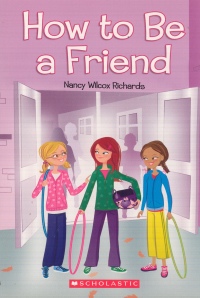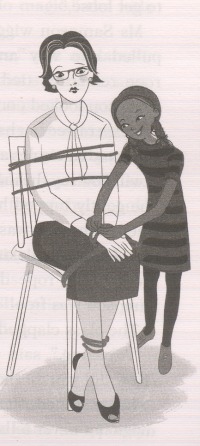| ________________
CM . . . . Volume XVII Number 31. . . .April 15, 2011. 
 |
How to Be a Friend.
Nancy Wilcox Richards. Illustrated by Annabelle Métayer.
Toronto, ON: Scholastic Canada, 2011.
91 pp., pbk., $5.99.
ISBN 978-1-4431-0485-2.
Grades 2-4 / Ages 7-9.
Review by Meredith Ball.
***/4
|
| |
|

excerpt:
She knew what was about to happen. She tried to form the words. But she couldn’t get them out fast enough. She needed to let Emma know! And then, almost in slow motion, Lexie swayed back and forth and slowly fell to the ground.
When she woke up, Mr. Johnson was kneeling beside her. She was lying on her side. Someone’s winter jacket was tucked beneath her head. Emma stood nearby, holding her helmet. She peered down at her, a worried look on her face.
Mr. Johnson was very calm. He smiled at Lexie. “You’re okay,” he said. “I bet you’re feeling tired, though. You just had a seizure.”
Lexie Peters is starting grade three in a new school, her third new school in only two years. She is nervous about making friends and fitting in, especially because she knows she is a bit different from everyone else. Lexie has epilepsy, and it affects the way she does some things, like how she has to wear a helmet outside and eat a special diet. Fearing they will think she is weird, Lexie is afraid to tell her new classmates about her epilepsy. As she goes through her first year at her new school, however, she learns that, with the help of her new friends, she can overcome many challenges, including a bully and a playground seizure.
Nancy Wilcox Richards’ chapter book is a fast-paced look at a young girl’s experience of trying to be just like everyone else. The narrative mostly follows Lexie but occasionally slips into the viewpoint of some of her friends, which adds an interesting depth to the tale, though it can be slightly confusing when the switch in viewpoint is first made. In addition to Lexie’s personal story, there is also a second ongoing plot in this book, that of Lexie’s class undergoing a year-long project involving random acts of kindness. Each week, a different student gets the Kindness Stone, and during that week, he or she has to perform a random act of kindness. These acts range from little things, like drawing a picture for someone or smiling at one hundred people in a week, to bigger things, like comforting a crying kindergartner and helping a blind boy with an Easter egg hunt.
 There are small, black and white cartoon images throughout this book, but, although they represent what is going on in the text well, they don’t really add anything to the story. The character of Marcus, the bully, is introduced into the story early on, but after an episode in which Marcus makes Lexie so mad she eats something she’s not supposed to and has to stay home for a few days to get her ketogenic diet back on track, the character kind of disappears. While this may show a somewhat realistic case of bullying in school, the fact that there is no resolution or lesson learned still makes the story feel a little incomplete. There are small, black and white cartoon images throughout this book, but, although they represent what is going on in the text well, they don’t really add anything to the story. The character of Marcus, the bully, is introduced into the story early on, but after an episode in which Marcus makes Lexie so mad she eats something she’s not supposed to and has to stay home for a few days to get her ketogenic diet back on track, the character kind of disappears. While this may show a somewhat realistic case of bullying in school, the fact that there is no resolution or lesson learned still makes the story feel a little incomplete.
How to Be a Friend provides a simple, straightforward, and accurate introduction to what epilepsy is. It provides readers with an understanding of what it can be like for someone living with a special condition, and it sends a clear message that sometimes being a friend is the best way to help someone out, no matter what the circumstance. This book provides some good information about the condition of childhood epilepsy and can be an effective learning tool, but beyond the educational information, this story really tells the simple tale of what it is like to be the new kid, deal with bullies, make new friends, and learn that everyone is different, and everyone is special.
Recommended.
Meredith Ball is currently completing her Masters of Library and Information Science in London, ON. She loves to read, write, and live in a world of pure imagination.

To comment on this title or this review, send mail to
cm@umanitoba.ca.
Copyright © the Manitoba Library Association. Reproduction for personal use is permitted only if this copyright notice is maintained. Any other reproduction is prohibited without permission.
NEXT REVIEW |
TABLE OF CONTENTS FOR THIS ISSUE- April 15, 2011.
AUTHORS |
TITLES |
MEDIA REVIEWS |
PROFILES |
BACK ISSUES |
SEARCH |
CMARCHIVE |
HOME |

 There are small, black and white cartoon images throughout this book, but, although they represent what is going on in the text well, they don’t really add anything to the story. The character of Marcus, the bully, is introduced into the story early on, but after an episode in which Marcus makes Lexie so mad she eats something she’s not supposed to and has to stay home for a few days to get her ketogenic diet back on track, the character kind of disappears. While this may show a somewhat realistic case of bullying in school, the fact that there is no resolution or lesson learned still makes the story feel a little incomplete.
There are small, black and white cartoon images throughout this book, but, although they represent what is going on in the text well, they don’t really add anything to the story. The character of Marcus, the bully, is introduced into the story early on, but after an episode in which Marcus makes Lexie so mad she eats something she’s not supposed to and has to stay home for a few days to get her ketogenic diet back on track, the character kind of disappears. While this may show a somewhat realistic case of bullying in school, the fact that there is no resolution or lesson learned still makes the story feel a little incomplete.